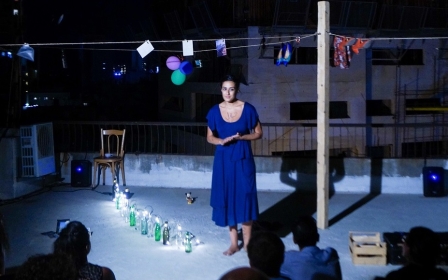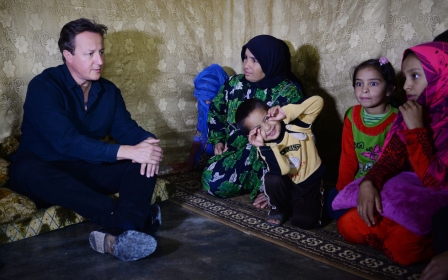Art-based therapy for young refugees: Can art save lives?
In war-torn Lebanon, a clinical psychologist is using her expertise to help teens cope with their trauma. She invites the public to participate too
A Syrian child taking part in an art therapy class in north Lebanon (MEE/Lara Kalaf)
Published date: 6 October 2015 16:07 BST
|
Last update: 9 years 2 months ago
With heightened global efforts to respond to the plight of the 12 million displaced citizens of Syria, one woman is trying to offer a different kind of support.
Meet Lara Kalaf. She is a Lebanese-born PhD candidate in clinical psychology in Canada whose life work has been dedicated to assisting those healing from traumatic experiences. Her credentials stretch over several countries and areas of expertise, in the humanitarian field and beyond. In addition to her clinical psychology studies, she has worked in human resources in an Alzheimer’s centre and was an emergency helpline counsellor for victims of sexual assault. Now, she is trying to help teens who have escaped the war zones unleash their creativity and introduce them to art-based therapy by producing a movie with them.
This will give the teens the power to shoot with a camera instead of getting shot at.
Stimulating the brain
“This is the first time someone in the scientific community is using participant-made movies to analyse the relationship between resilience and art with war-affected children," Kalaf tells Middle East Eye.
"It is academic research and a psychosocial intervention. Kids develop through play. The pathways in the brain die off if you don’t stimulate them."
Refugee children are living in the worst possible conditions in her native Lebanon at the moment. With the recent surge in the number of refugees from Syria and Palestine and the increase in poverty and deteriorating living conditions, aid has had to come in different forms. Many teens are forced to work, support their stressed-out parents and become adults well before their time.
Coming together
Kalaf has chosen to use a very modern method to cope with an older problem: crowdfunding.
“By crowdfunding I will be completely independent and impartial while implementing the intervention and analysing the research results,” she writes on her campaign page.
Why art? “In my own life, for a very long time, I never valued art," she says.
"I grew up in Kuwait and half of my life was in Canada. I never felt the need to do anything artistic as a kid and instead opted for a path that seemed rational, business-oriented. When I started doing my PhD, it just clicked in my head: art is great. I realised that money isn’t what makes us happy, it’s the small things like falling in love and reading a book. Making art, I realised, is one of those things that makes people happy."
She decided to integrate art into her thesis to help the most affected youth. Some of these teenagers had just come from Syria, where their parents were put into prisons or killed. Several of them were badly abused and the teens she surveyed were “extremely ecstatic” to incorporate art into their lives.
Kalaf is consulting with NGOs to select teens who have had art therapy before and whose lives were drastically affected as a direct consequence of war. She is starting her project in Lebanon and including teens from any region who reside there. Seven boys and seven girls between the ages of 12 and 14 will be chosen to participate at no cost to them.
They will be able to “learn to be kids again”.
Art camp
For 10 consecutive days, they will meet in the mornings and spend about five hours together every day. They will be provided with free transportation, a healthy breakfast and lunch in addition to the workshop time. The teens will have control over what kind of art they’d like to do: Painting, drawing, collaging, sculpture and anything else that occurs to them. That process and the final works will be filmed and eventually turned into a movie. Since many of these teens were forced into child labour, sexual abuse and exploitation, the boys and girls will have classes separately.
The resulting movie collaboration will be visual evidence that speaks authentically about their experiences and feelings. It will provide them with a platform and voice.
Kalaf is not alone in opting to use creativity, in particular film, as a healing tool. Animator Diaa Malaeb, who has worked with refugee children for Save the Children Lebanon's Animation Project, said in his experience it was possible to empower teens by using the camera as a vehicle to connect.
"Art is an international tool and language that can be used by anyone, and reaches everyone without any chains. Art in general is an easy, safe and participatory tool to use with children, especially refugees, where through it they release their stress, overcome their fears and talk about their experience without exposing them to any risks,” Malaeb explained. "When they see that others are listening to and appreciating them, this gives them confidence and self-esteem to overcome the trauma they passed through during war."
The camera connects
Taking pictures and sharing video is already a common way that teens communicate on social media. With Instagram, YouTube, Twitter and Facebook, teens are instantly capturing and sharing images and videos on their small mobile phone screens. In the Arab world, art isn’t necessarily celebrated, but everyone appreciates pictures and movies.
“I love movies and when we make a movie about something, we get the context in which these kids live. It comes naturally in the movie; it’s something you understand. It’s not enough with just reading or looking at a photo,” Kalaf said.
Kalaf anticipates some resistance from parents. When offered the choice between academics and art activities, most parents would send their children straight to school, which is a dwindling prospect as it is. The resources for art programmes in war-torn countries in the Arab world are slim to nonexistent. Kalaf is offering the teens a fun environment in which to thrive. “They have nothing to lose,” she says.
One step at a time
During her research, she noticed that children needed to be eased into art. At first, their renderings would be very nationalistic, drawings of a house with a family or a flag. After a week or two, she anticipates that the deeper meanings of their lives will start to emerge on the pages and on the screens.
The programme will also provide an opportunity to discuss the concept of art with parents, to help them understand that art is important for them and their kids. Films can help heal.
“The movies will focus on how the kids psychologically coped with the harsh conditions of war and how art-making may have acted as a protective shield,” she says.
Spreading the love
To start with, art has to be viewed with the value it provides. Steffanie Lorig is founder of Seattle-based non-profit Art with Heart, which supports the emotional well-being of children adversely affected by hardship. "I believe passionately in the ability of creativity to heal the heart," she tells MEE. "Why? Because I see it work every single day – in both big ways and small. I've seen it work to help the youngest victims after Hurricane Katrina. I've seen it work in the classroom after a student death. I've seen it after the school shooting in Newtown. And I've seen it work in Nepal after the earthquake."
"The proof is in watching children – who tend to have limited emotional vocabulary – release their pain and confusion and not have to carry it into adulthood with them. Creativity connects what’s inside our heads to our hearts."
Kalaf's art-based intervention will help her reach out to this vulnerable population in the refugee communities of Lebanon.
“This project is for children who are forced to deal with the negative consequences of war, regardless of race, religion or gender. It is academic research and a psychosocial intervention,” she said, “We need to continue evolving - art happens naturally and has been for centuries. With war comes trauma; this [project] is a way to analyse these individuals for a fun day. These kids only knew war. What are ways in which art can lift those tears?”
Kalaf’s hope is that the research-action project will be replicated in different countries, in order to allow for cross-country comparison and to organise an awareness-raising campaign.
“I am planning to implement an action-research project targeting war-affected children in Lebanon, a country that has been dealing with internal conflict as well as the spillover effect of incoming refugees from Syria, Iraq and Palestine. Through art-making I am hoping to find out what children affected by armed conflict need to better cope with their current situation. This is what I call psychological resilience,” she says.
New MEE newsletter: Jerusalem Dispatch
Sign up to get the latest insights and analysis on Israel-Palestine, alongside Turkey Unpacked and other MEE newsletters
Middle East Eye delivers independent and unrivalled coverage and analysis of the Middle East, North Africa and beyond. To learn more about republishing this content and the associated fees, please fill out this form. More about MEE can be found here.






